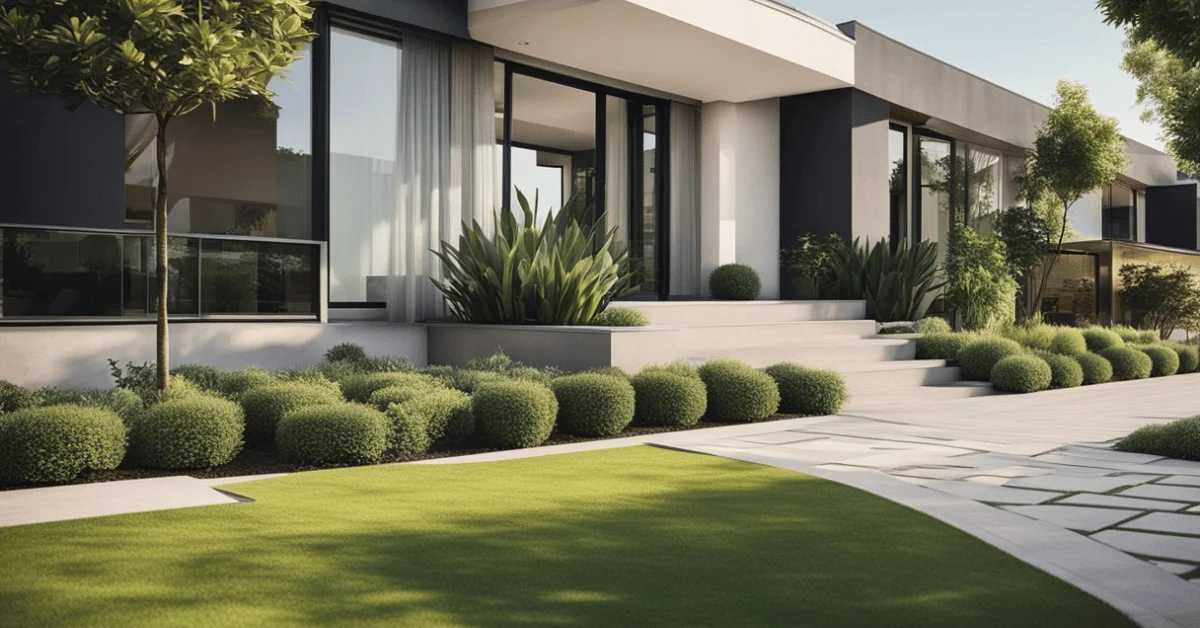Minimalist front yard landscaping brings simplicity and elegance to the exterior of a home, tapping into the essence of modern design.
By focusing on a restrained selection of materials, colors, and plants, this approach to landscaping creates an organized and soothing outdoor space. It is an invitation to embrace less clutter and more open, functional areas that highlight the natural beauty inherent in simplicity. A minimalist landscape is not only aesthetically pleasing but also often requires less maintenance, making it a practical choice for many homeowners.
Planning a minimalist front yard begins with a clear understanding of the space. We consider factors like the size of the yard, the local climate, and the architectural style of the house. Next, we select a few plant species that can create visual interest without overwhelming the space. We also look at hardscaping elements such as pavers, rocks, and gravel to achieve a clean and crisp look.
The beauty of minimalist front yard landscaping lies in the precise execution of a well-thought-out design that complements the home’s exterior while offering a tranquil retreat.
Key Takeaways
- Minimalist landscaping emphasizes simplicity, functionality, and low maintenance.
- A clear, well-planned design integrates with the home’s architecture for coherent aesthetics.
- Choosing the right plants and materials can enhance curb appeal while reflecting personal style.
Planning Your Minimalist Front Yard Landscaping
As we craft our minimalist front yard landscape, we prioritize simplicity, cohesion with our home’s architecture, and functionality. Our planning process involves a clear understanding of minimalist principles, thoughtful evaluation of our specific space, and the selection of a strategic focal point.
Understanding Minimalist Principles
Minimalist front yard landscaping hinges on the concept of less is more. We emphasize clean lines, geometric forms, and a monochromatic palette. A minimalist approach often involves:
- Scale: Adjusting the size of landscape elements to fit the space neatly.
- Line: Using strong visual lines that lead the eye and create structure.
- Form: Selecting simple, repeated shapes for a coherent look.
Evaluating Your Front Yard Space
To integrate our minimalist design with the existing space, we assess our front yard’s dimensions and the architecture of our home. We ask questions such as:
- How does the yard’s size influence our design choices?
- What are the sun and shade patterns throughout the day?
Our evaluation must consider the practical aspects like maintenance, allowing us to anticipate the long-term sustainability of our minimalist front yard landscape.
Choosing a Focal Point
A focal point anchors our minimalist front yard landscape and draws attention. This could be an architectural feature of our home or a distinctive element within the yard. When choosing a focal point, we consider:
- Visibility: It must be easily seen from the main viewing angles.
- Proportion: The size of the focal point should complement the scale of the yard.
With these considerations in mind, we can effectively plan our minimalist front yard landscape with confidence and clarity.
Selecting Plants and Trees
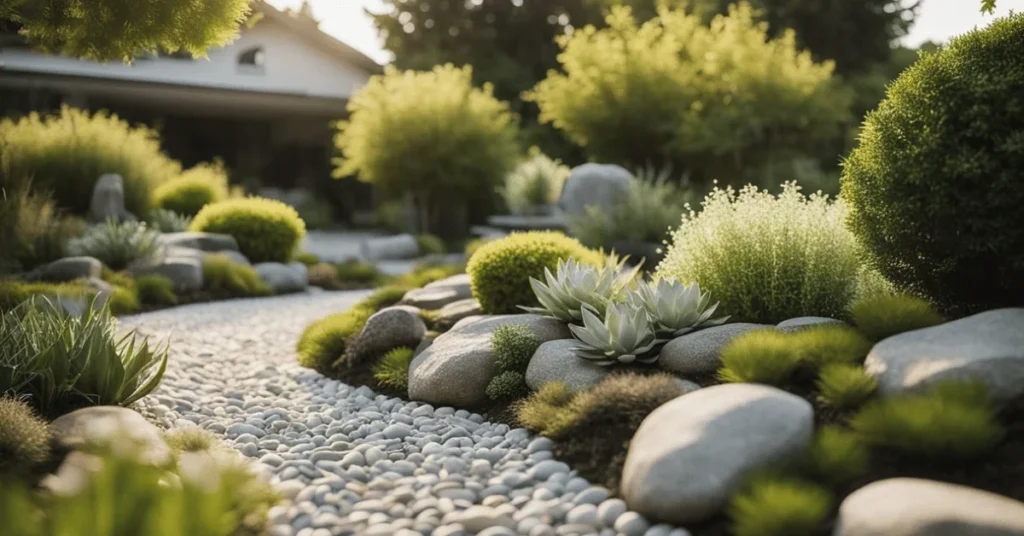
When we approach minimalist front yard landscaping, our plant and tree selection revolves around simplicity, ease of maintenance, and aesthetic appeal.
Incorporating Native Plants
Native plants offer the ideal balance between natural beauty and low-maintenance. We consider these for several reasons:
- Adaptability: Native species are adapted to the local climate and soil, reducing the need for water and fertilizers.
- Wildlife Support: They provide food and habitat for local wildlife.
| Native Plant Examples | Benefits |
|---|---|
| Coneflowers (Perennials) | Drought-tolerant and attracts pollinators |
| Blue Sage (Perennials) | Low maintenance, full sun tolerance |
| Red Osier Dogwood (Shrubs) | Provides winter interest and is adaptable to various soils |
Using Ornamental Grasses
Ornamental grasses add texture and movement to our minimalist front yard landscaping. Here’s why they’re a staple:
- Versatility: Grasses blend well with other plants or make a statement on their own.
- Year-round Interest: Many grasses provide structure and color even in winter.
| Ornamental Grass Examples | Features |
|---|---|
| Feather Reed Grass | Upright growth, low maintenance |
| Blue Oat Grass | Steel-blue coloring, hardy |
| Purple Fountain Grass | Showy foliage, fast-growing |
Strategizing Trees and Shrubs Placement
We carefully position trees and shrubs to create a balanced, uncluttered look. Our strategies include:
- Focal Points: Using evergreens or topiaries as central features for year-round interest.
- Borders: Lining pathways with boxwoods to define spaces without overcrowding.
| Tree and Shrub Examples | Function |
|---|---|
| Japanese Maple (Tree) | Provides elegant structure and color |
| Olive Tree (Evergreen) | Drought-tolerant, offers a Mediterranean feel |
| Dwarf Boxwood (Shrub) | Ideal for clean, formal borders |
Design Elements and Materials
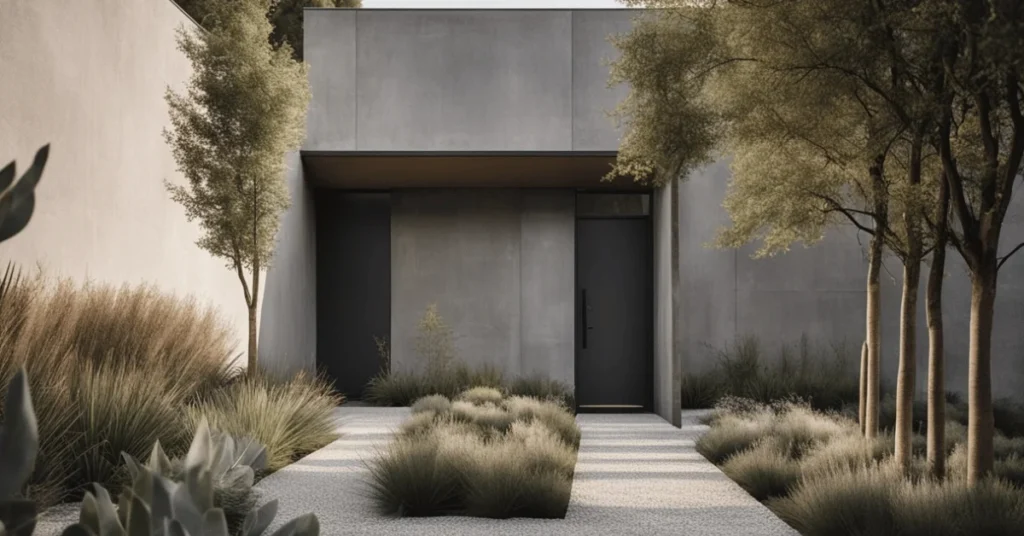
In our approach to minimalist front yard landscaping, we focus on clean lines, natural colors, and durable materials. Simplicity reigns, ensuring each element serves both a practical purpose and an aesthetic function.
Innovative Hardscaping Ideas
We use hardscaping to establish form and line in our minimalist front yard landscaping design. Concrete is a versatile material that, when used in straight lines or geometric shapes, anchors our design with its neutral color and smooth texture. We also incorporate steeledging for its sleek appearance and longevity. Here are a couple of hardscaping ideas:
- Linear Concrete Pavers: Arranged in a rectilinear pattern for modern appeal.
- Steel Edged Beds: Steel provides a clean line separating planted areas from gravel.
Functional Pathways and Edging
Pathways guide movement and flow. We create functional pathways using materials like limestone or granite, favoring their durability and natural hues. Edging plays a critical role in defining spaces. For edging, we often select materials like steel for a crisp boundary that is both subtle and long-lasting.
- Pathway Material Choices
- Limestone: Light-colored and durable, ideal for a bright and welcoming path.
- Granite: A harder stone that resists wear, in grays and other earthen tones.
- Edging Options
- Steel: Provides a thin, almost invisible line that holds up against the elements.
- Wood: Adds a warm, organic touch while maintaining the minimalist ethos.
Accentuating with Rocks and Gravel
Rocks and gravel bring texture and color to our minimalist design palette. We select rocks like river rock or chunks of granite to create focal points or to serve as a low-maintenance ground cover. Gravel, with its myriad of shades and textures, fills in the understated spaces of our landscapes, harmonizing with other elements.
- Rock Selection
- River Rock: Smooth and rounded for a soft, natural look.
- Granite Chunks: Rugged edges provide a stark visual contrast.
- Gravel Types
- Pea Gravel: Small, rounded, and comfortable underfoot.
- Crushed Granite: Offers a coarser texture for visual interest and stability.
Minimalist Front Yard Landscaping Features
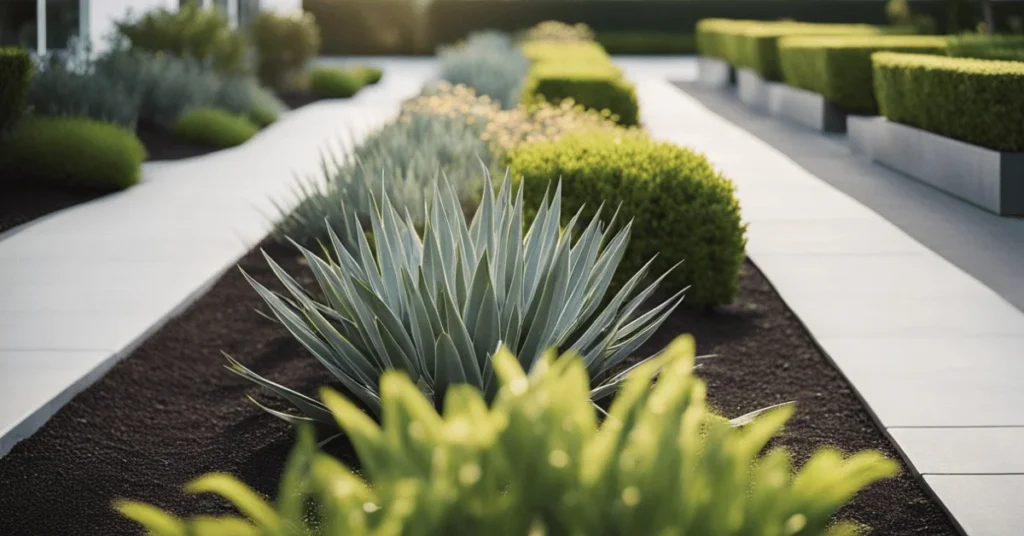
In minimalist front yard landscaping, we focus on simple, yet impactful elements. We integrate soothing water features, enhance ambience with strategic lighting, and provide structure through thoughtfully designed walls and fences.
Integrating Water Features
To add tranquility to the yard, we consider installing a stream or a garden fountain. These water features serve as focal points and can be tailored to fit small spaces without overwhelming the minimal aesthetic.
- Stream: A slender, winding stream creates a natural flow, guiding the eye across the yard.
- Garden Fountain: A single, sculptural fountain becomes a serene centerpiece.
Enhancing with Landscape Lighting
Strategic minimalist front yard landscaping lighting can accentuate the yard’s features and extend usability into the evening hours. Here’s how we achieve this:
| Feature | Lighting Technique | Description |
|---|---|---|
| Walkways | Low-level path lights | Ensure safe footing and guide visitors. |
| Water Features | Underwater lights | Highlight the movement of water. |
| Plants | Spotlights or backlights | Create dramatic silhouettes or showcase specimen plants. |
Building Walls and Fences for Structure
Finally, walls and fences add definition to minimalist front yard landscaping designs. We use them as follows:
- Walls: A low, sleek wall can delineate space, serve as a backdrop for plants, or double as seating.
- Fence: A simple, horizontal slat fence provides privacy without sacrificing style. It complements the minimalist theme and can support climbing plants for a touch of greenery.
Sustainability and Maintenance
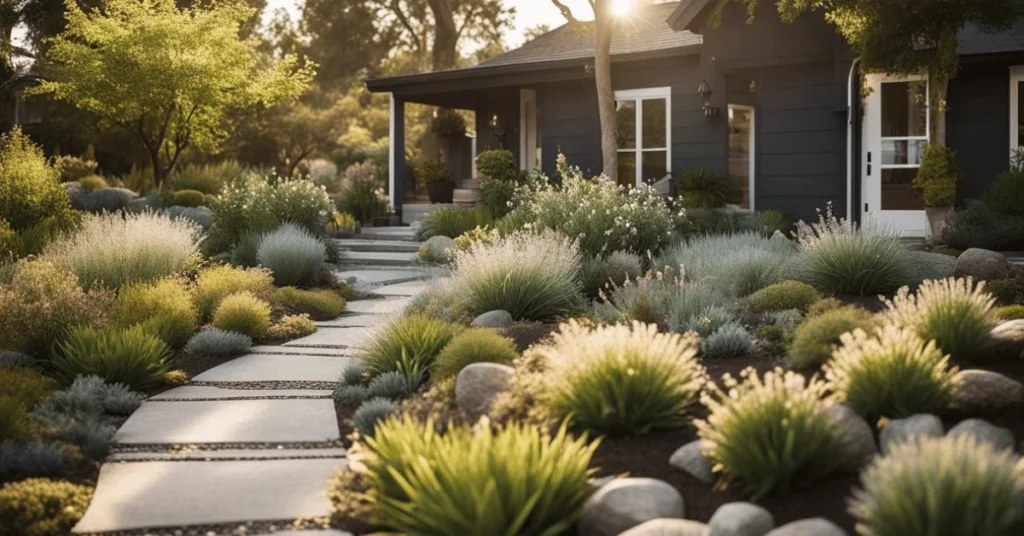
In creating a minimalist front yard that is both sustainable and easy to maintain, we must consider the selection of plants, watering methods, and ground coverage options that reduce the need for upkeep and conserve resources.
Opting for Low Maintenance Options
We prioritize plants that require minimal care so that our minimalist front yard landscaping remains low maintenance. This includes:
- Perennials: Require less frequent replacement than annuals
- Native plants: Adapted to local climate, require less care
- Shrubs: Provide structure with little upkeep
Using mulch is also essential as it suppresses weeds and reduces water evaporation.
Sustainable Watering Techniques
Our approach to irrigation focuses on efficiency to ensure we use water responsibly:
- Drip irrigation: Directs water to plant roots, minimizing waste
- Rain barrels: Collect rainwater for later use
- Timed sprinklers: Water at optimal times to reduce evaporation
We ensure that watering occurs either early in the morning or late in the evening when the sun’s impact is minimal.
Choosing Blooms and Ground Cover Wisely
Selecting the right blooms and ground cover is crucial for sustainability:
- Drought-tolerant plants: Require less water and are hardy
- Local ground cover: Needs less water and is adaptive to our area
By focusing on these options, we foster a yard that thrives with minimal intervention. This not only creates an aesthetically pleasing space but also one that supports our local ecosystems.
Creating Curb Appeal
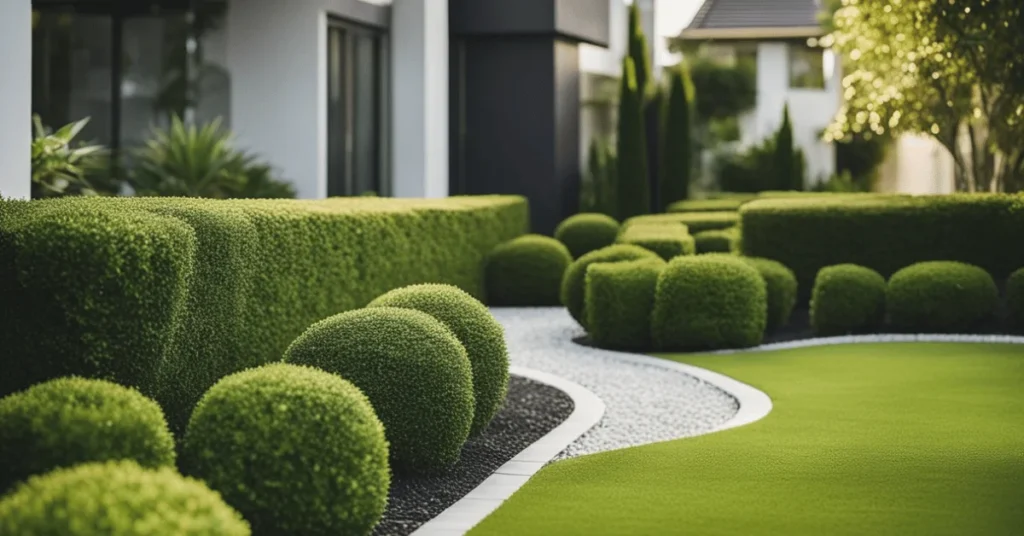
Curb appeal sets the tone for your home’s exterior by blending simplicity with style. Our focus is on crafting an entrance that welcomes guests and balancing the beauty and practicality of your outdoor spaces.
Crafting an Inviting Entrance
We prioritize functionality while introducing elements that draw the eye. For a minimalist approach:
- Pathways: A clean, clear path made of flagstones or pavers offers both direction and design, guiding visitors to your door.
- Lighting: Use low-profile, solar-powered lights to illuminate the pathway, ensuring safety after dusk.
Incorporating garden beds or flower beds along the walkway adds a hint of nature without overwhelming the space. Choose perennial plants for year-round appeal.
Balancing Aesthetics and Functionality
We achieve an elegant look in minimalist front yard landscaping without sacrificing usability by:
- Lawn Care: Keeping the grass well-trimmed and green creates a uniform backdrop for the landscape.
- Plant Selection: Opt for low-maintenance shrubs and plants that provide visual interest without excessive upkeep.
Remember, symmetry and spacing in garden designs contribute to a grand entrance, enhancing the visual appeal of your front yard. Use decorative elements sparingly to maintain a clean aesthetic.
Detailing Planting and Growth
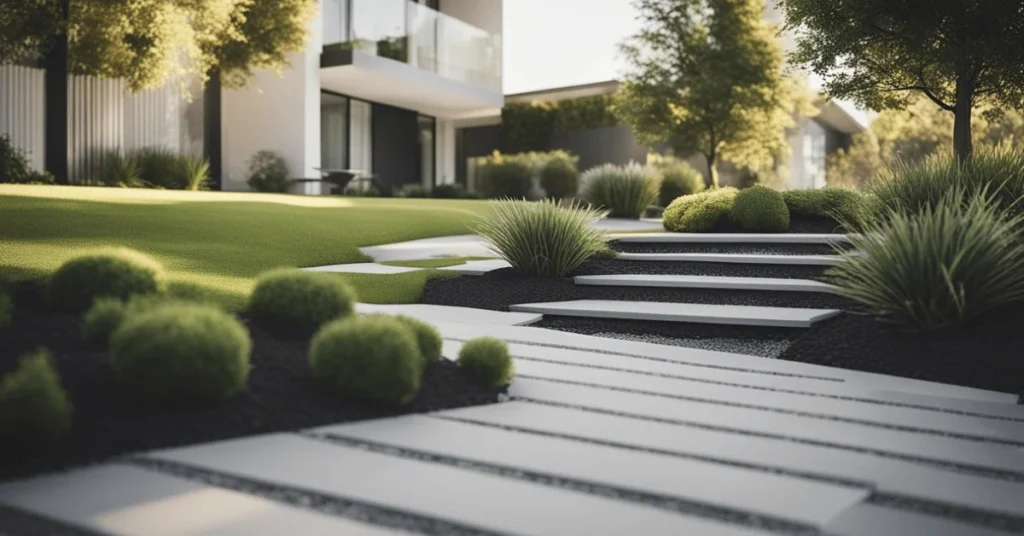
In minimalist front yard landscaping, we pay close attention to the planting lifecycle and growth habits to maintain a clean aesthetic. Our approach reflects a balance between beauty and practicality, ensuring every plant serves a purpose.
Seasonal Considerations for Planting
When we plant is as important as what we plant. Deciduous trees, like the crepe myrtle, should be planted in fall or early spring when dormant. This timing helps them establish roots without the stress of extreme temperatures. We often choose such trees for their ability to create light, dappled shade in summer while allowing sunlight to pass through in winter.
Deciduous Tree Planting Schedule:
- Fall: September to November, before the first frost.
- Spring: March to May, after the last frost.
Managing Sunlight and Shade
We manage sunlight and shade in our minimalist front yard landscaping structure by strategically placing shade trees. These trees are sited where they’ll provide relief from the hottest afternoon sun without creating deep shade. In the heat of summer, sunlight can be intense. By carefully positioning a shade tree or two, we reduce the heat, yet allow enough light to keep the yard bright.
Optimal Sunlight Management:
- Morning: Full exposure for dew to evaporate.
- Afternoon: Partial shade to protect plants and reduce heat.
Practical Tips for Mowing and Trimming
Mowing and trimming are essential to the minimalist aesthetic, done frequently enough to maintain cleanliness, but sparingly to respect the plants’ health. We keep grass at a height to balance neatness with drought tolerance. Edges are kept crisp, defining garden beds and pathways clearly.
Mowing Guidelines:
- Height: 2.5 to 3 inches to promote root growth and drought resistance.
- Frequency: Weekly during peak growing seasons; less often as growth slows.
Practical trimming of deciduous trees like the crepe myrtle is done after blooming to shape the tree and remove any dead or damaged branches.
Trimming Tips:
- Prune deadwood to promote healthy growth.
- Shape for aesthetics but avoid over-pruning.
Accessorizing the Minimalist Yard
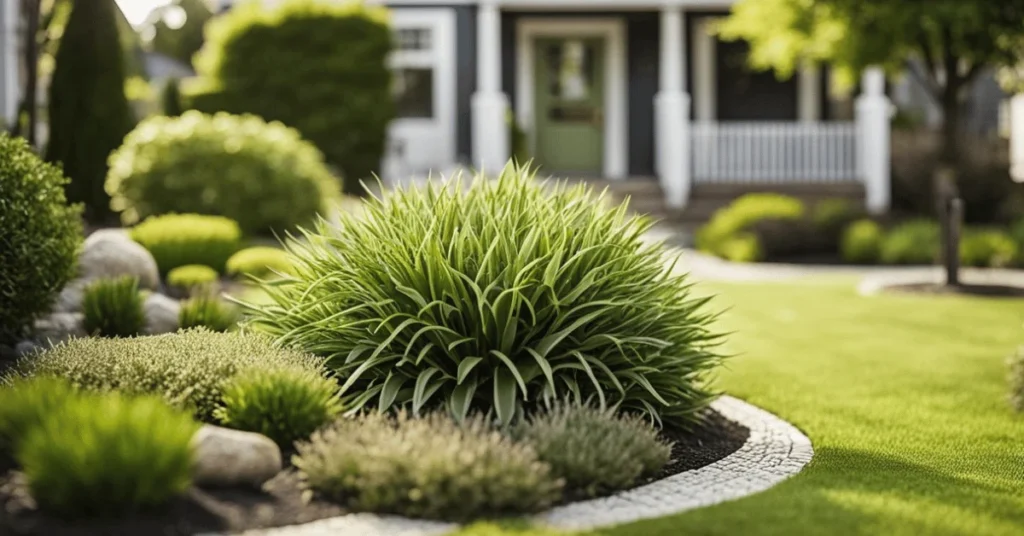
In minimalist front yard landscaping, every element we select serves a purpose and is part of the overall design palette. We pay close attention to the design elements utilized, focusing on quality over quantity.
Decor with Containers and Beds
Garden beds and containers are ideal for adding greenery and flair without overwhelming the space. Containers allow us to control the aesthetic: rectangular or cylindrical pots can provide a modern feel, while stone or concrete planters add a touch of permanence.
- Garden Beds: We use low-maintenance plants in sleek, raised beds to introduce harmony.
- Placement: Positioning beds along the walkway or against the house subtly enhances the architecture.
- Plants: We select species that require minimal pruning, such as ornamental grasses.
Incorporating Art and Architecture
A well-placed sculpture or architectural feature can become a focal point in our minimalist front yard landscaping, drawing the eye and adding visual interest without cluttering the outdoor space.
- Art: A single, thoughtfully chosen piece can make a powerful statement.
- Materials: We opt for materials that complement our home’s façade.
- Architecture: The incorporation of geometric shapes and lines can prolong the visual flow from our home to our yard.
- Structures: Minimalist arbors or pergolas can define an area while preserving openness.
Finalizing the Front Yard Design
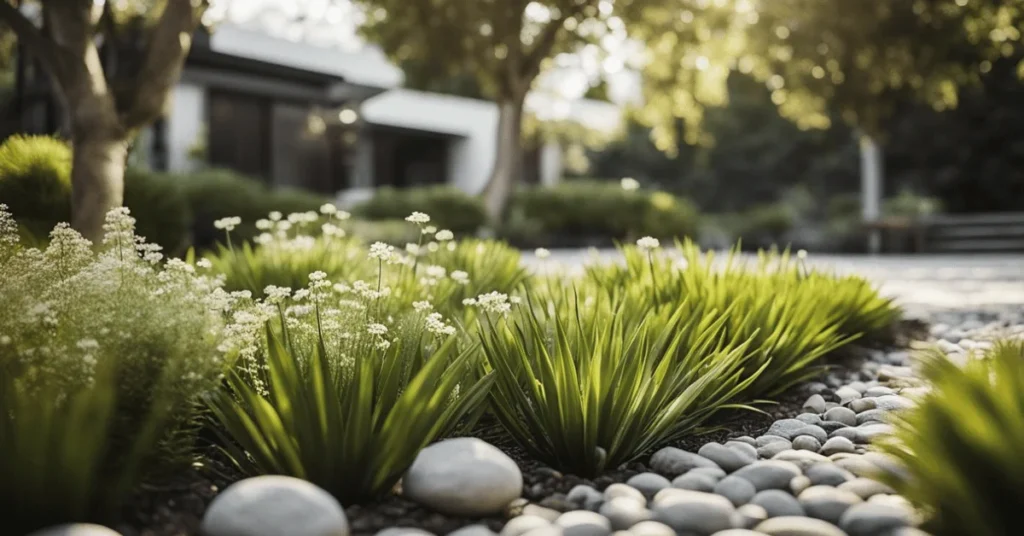
As we approach the completion of our front yard transformation, focusing on the precise execution of our design plan and the integration of driveways and walkways is crucial for achieving a seamless and functional aesthetic.
Implementing the Design Plan
To ensure our landscape design adheres to our minimalist vision, it’s imperative to follow the design plan meticulously. We start by preparing the soil in designated areas to accommodate new plantings. Here’s a checklist to guide us:
- Soil Preparation: Amend and till to improve soil quality.
- Clear unwanted vegetation and debris.
- Plant Placement: Position plants according to the plan, considering mature size for adequate spacing.
- Mulching: Apply a layer to control weeds and retain moisture.
- Maintenance Schedule: Set up a routine for watering, pruning, and fertilizing.
By sticking to our plan, we maintain cohesiveness and prevent overcomplication of our front yard’s design.
Considering the Impact of Driveways and Walkways
Our front yard’s functionality significantly depends on well-thought-out driveways and walkways:
- Driveways:
- Material Selection: Opt for materials that complement the house, such as concrete, asphalt, or pavers.
- Design Elements: Simple geometric shapes or gentle curves enhance the minimalist look without overpowering.
- Walkways:
- Align with the main door for natural flow and symmetry.
- Pathway Width: Ensure it’s wide enough for comfortable passage, at least 36 inches.
- Lighting: Subtle, low-voltage lighting for safety and ambiance.
Remember, the right driveway and walkway design will reinforce the minimalist theme while ensuring practicality and curb appeal.
Adapting to Lifestyle and Comfort
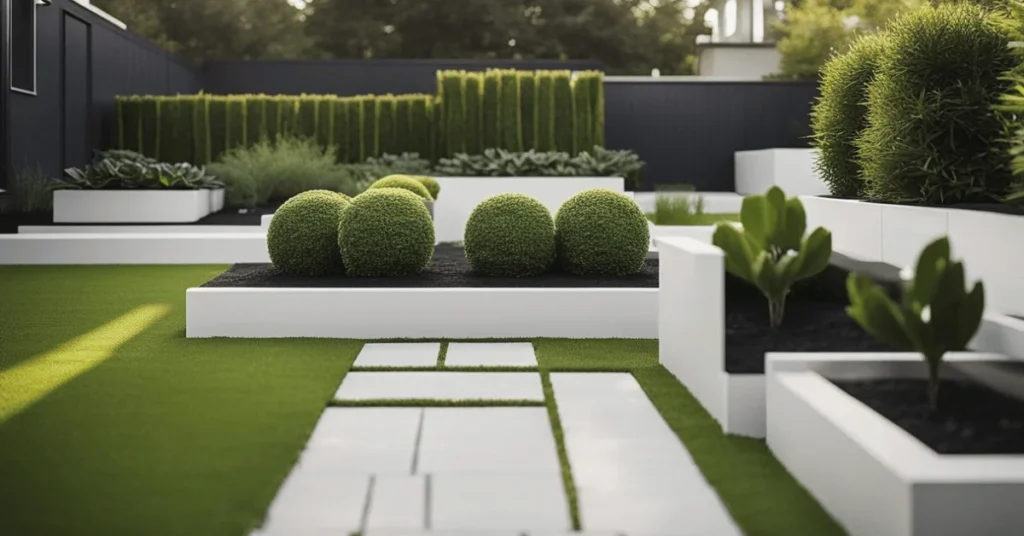
We understand that our outdoor space needs to blend seamlessly with our lifestyle while providing maximum comfort.
Integrating Comfortable Outdoor Spaces
To create an inviting outdoor area, we start by considering the daily routines of our household. For example, if we enjoy morning coffees outdoors, we might opt for a comfortably sized patio with space for a small table and chairs. Or, if we seek a spot for evening relaxation, we could position garden benches or a swing where we can soak up the last rays of the sun.
Here’s a simple framework to guide our planning:
- Purpose: Determine how we intend to use the space (e.g., dining, lounging, play).
- Furnishings: Choose low-maintenance, weather-resistant furniture that supports our intended use.
- Materials: Select surfaces that provide safety and comfort underfoot, such as wooden decking or smooth paving stones.
- Shade and Shelter: Incorporate elements like a pergola or awning to create areas of refuge from the sun or rain.
By focusing on these aspects, we ensure that our front yard is not only aesthetically pleasing but also fulfills our desire for comfort and suits our lifestyle.
Reflecting Architectural Style
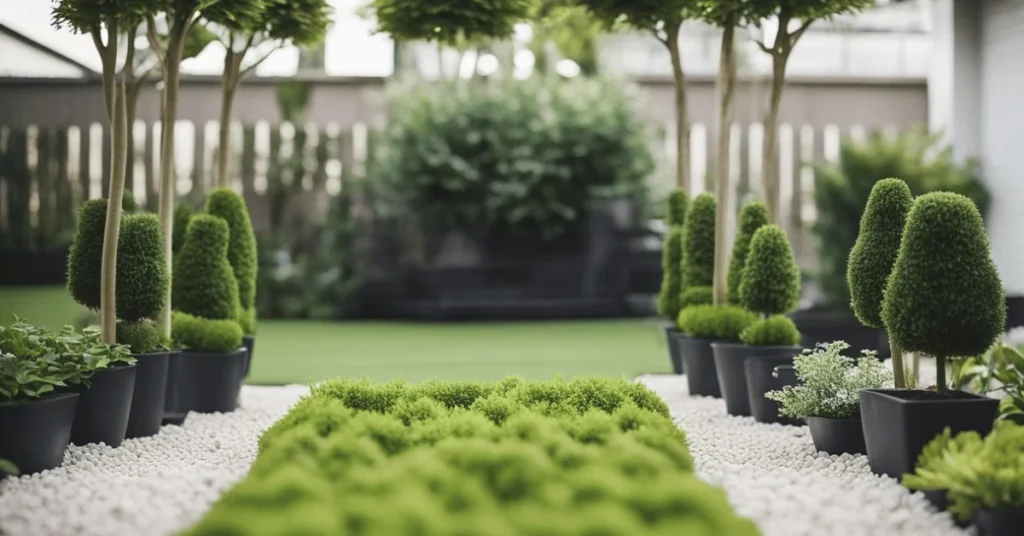
In minimalist front yard landscaping, we ensure that our landscape design not only complements but also enhances the architectural style of our home.
Complementing Home Architecture with Landscaping
Before we select plants or design elements for our front yard, we consider the defining features of our home’s architectural style. Is it a mid-century modern with clean lines and a non-fussy aesthetic, or perhaps a Victorian home craving balance between intricate detail and simplicity? Here’s how we approach various styles:
- Contemporary Homes:
- Materials: Use sleek and modern materials that align with contemporary architectural features. This might include smooth concrete for pathways or minimalist metal edging.
- Plants: Opt for structured plantings with a clean aesthetic, such as ornamental grasses or geometric shrubbery, that echo the home’s modern lines.
When integrating landscape design with architectural style, our goal is to create a harmonious visual flow from the building to the surrounding yard. Achieving this balance requires a deliberate selection of elements that share a common design language with the structure they complement.
Nurturing Your Minimalist Garden
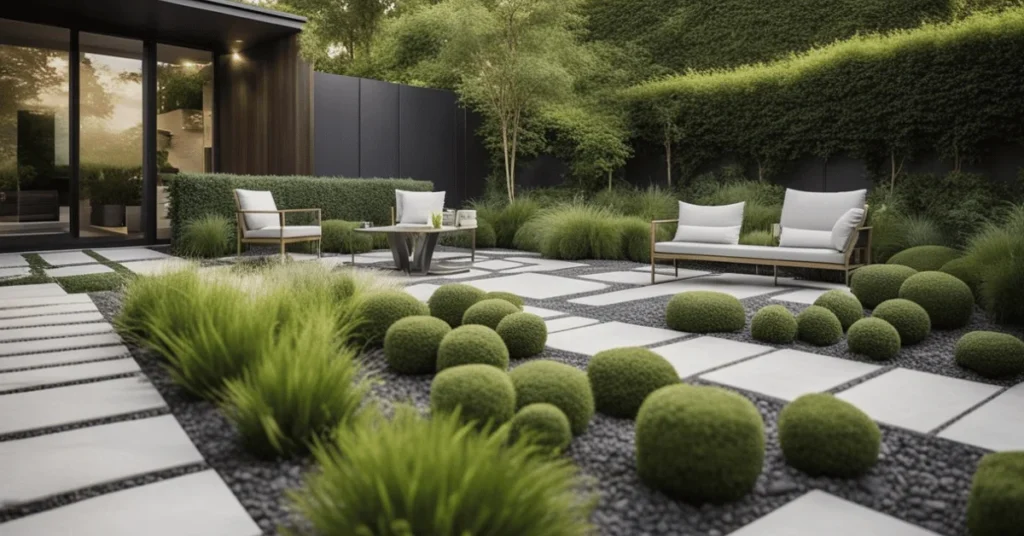
Maintaining a minimalist garden involves strategic care to ensure that the simplicity of design and plant choice remains refined and sustainable throughout the seasons.
Long-Term Care for Evergreens and Perennials
In our minimalist gardens, we often rely on a foundation of evergreens and perennials for their reliable structure and recurring beauty. Appropriate long-term care is crucial to keep these plants thriving.
Evergreens, such as boxwood, are a staple in minimalist designs, especially when used for garden edging. Their consistent foliage offers year-round color and structure. To nurture them:
- Prune regularly to maintain a tidy appearance. For boxwood, pruning is best done in late spring after new growth has hardened.
- Water deeply, but infrequently, to promote strong root growth. During dry periods in climates like New York’s, a weekly watering may be necessary.
- Mulch to conserve moisture, regulate soil temperature, and reduce weeds.
| Care Aspect | Boxwood |
|---|---|
| Watering Frequency | Weekly during drought; less often otherwise |
| Pruning Season | Late spring |
| Mulch Depth | 2-3 inches |
Perennials, such as black-eyed Susan and various sedge varieties, bring a flush of colors and textures to the garden and require different considerations:
- Deadheading: Remove spent blooms of black-eyed Susan to encourage more flowers.
- Dividing: Every few years, divide perennials to maintain vigor and control spread.
- Fertilizing: Apply a balanced fertilizer in early spring to support growth.
Bamboo is also a popular choice in minimalist gardens for its elegant and upright growth habit. When including bamboo:
- Contain: Use barriers to prevent bamboo from becoming invasive.
- Trim: Cut away any unwanted or overgrown shoots to preserve the clean lines of the garden design.
| Plant | Special Care Note |
|---|---|
| Black-eyed Susan | Deadhead regularly |
| Sedge Varieties | Divide to rejuvenate |
| Bamboo | Contain with barriers |
By focusing on these essential care practices, we can ensure our minimalist garden remains a serene and well-kept space.
Setting a Budget and Expectations
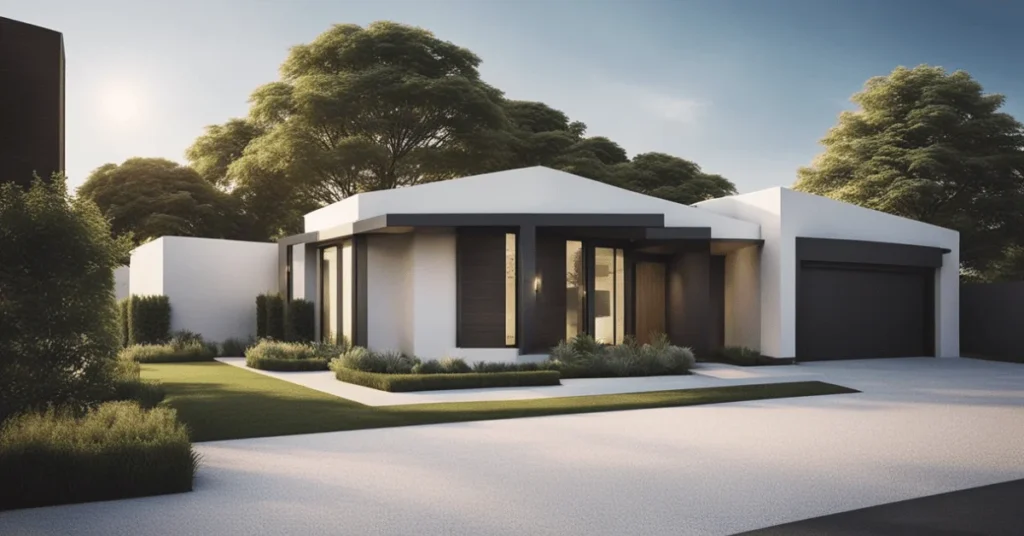
Before diving into the specifics of minimalist front yard landscaping, we must understand the importance of setting a practical budget and aligning our landscaping dreams with our financial means.
Calculating Costs for Upfront and Ongoing Expenses
When planning our front yard design, we need to account for both initial and future expenses. Upfront costs generally include:
- Landscaping design: Professional fees if we hire a designer.
- Materials: Costs for plants, mulch, stones, and hardscape materials.
- Labor: Installation fees if we employ contractors.
To outline ongoing expenses, let’s consider:
- Maintenance: Regular garden upkeep, including watering and trimming.
- Upgrades: Potential future costs for plant replacements or additions.
Here’s a simple table detailing potential upfront costs:
| Expense Category | Estimated Cost Range |
|---|---|
| Design Fees | $200 – $2,000 |
| Materials | $500 – $5,000+ |
| Labor | $1,000 – $10,000+ |
| Total | $1,700 – $17,000+ |
Remember that ongoing expenses vary based on yard size, choice of plants, and climate conditions.
Aligning Vision with Financial Planning
Our landscaping vision needs to be guided by the budget we set. To ensure our financial plan is realistic, we can:
- Prioritize features: Decide what elements are essential—be it low-maintenance plants or a stone pathway—and allocate funds accordingly.
- Seek alternatives: Research cost-effective substitutes for expensive materials or plants.
- DIY when possible: Performing some tasks ourselves can reduce labor costs significantly.
By integrating careful financial planning into our minimalist front yard landscaping project, we guarantee that our minimalist yard fulfills our aesthetic desires without straining our wallet.
Customizing the Front Yard Experience
In transforming our front yard into a personalized and inviting extension of our home, we carefully select plants and structures that reflect our aesthetic preferences, creating a welcoming and beautiful space.
Personalizing with Unique Plants and Structures
When selecting plants, we consider texture and scale to add visual interest and create a balanced look. Mixing different leaf types and plant sizes helps us produce a dynamic and attractive minimalist front yard landscaping. Here’s how we can personalize our space:
- Plant Choices:
- Texture: Incorporate grasses for softness and succulents for a modern touch.
- Scale: Use dwarf trees or large shrubs as focal points to draw the eye and add structure.
Incorporating custom structures like arbors or trellises can introduce line and shade, defining spaces and providing relief from the sun. We might add a small water feature or ornamental objects that mirror our personality and style, ensuring our front yard feels unique to us.
- Structures for Interest:
- Pathways: Craft curved walkways with stone or pavers, leading visitors through the front yard.
- Seating: Introduce benches or a small patio area for relaxation, making the space more inviting.
By combining these elements with consideration to the overall scale and line, we create a cohesive and personalized minimalist front yard landscaping that not only reflects our unique style but also welcomes guests into a beautiful, serene environment.
Considering the Change of Seasons
When we craft a minimalist front yard landscape, we must account for the ebb and flow of the seasons. Our designs integrate seasonal variations and climate resilience to maintain year-round appeal and functionality.
Adapting the Landscape to Weather and Seasonal Changes
To ensure our minimalist front yard landscaping thrives throughout the year, we focus on the selection of plants and materials that withstand seasonal shifts. Weather patterns influence our planning; we incorporate durable hardscaping and select plants that are not only aesthetically pleasing but also hardy against local weather extremes.
- Spring and Summer: We opt for plants that peak in the warmer months, ensuring constant growth and bloom. We consider the path of the sunlight and create a balance of sun and shade to protect plants from excessive heat.
- Spring: Early bloomers like Crocus and Snowdrop provide a splash of color.
- Summer: Heat-tolerant foliage like Sedum or Ornamental Grasses maintain the minimalist aesthetic without excessive maintenance.
- Fall and Autumn: Our focus shifts to plants with striking foliage that capture the essence of fall. Deciduous options that display seasonal color change contribute to our minimalist front yard landscaping vision.
- Deciduous trees such as Maples for bold autumnal hues.
- Winter: We ensure that our front yard remains engaging by incorporating evergreens and structures with winter interest, such as garden sculptures or boulders. These elements remain visible even under a blanket of snow.
- Evergreen shrubs and conifers provide greenery amidst the snow.
Throughout these seasonal transitions, understanding and supporting the local ecosystem is crucial. We select native plants that offer shelter and sustenance to the local wildlife, fostering a harmonious and sustainable environment. Our minimalist approach is not about the mere reduction of elements but the strategic choice and placement to create a resilient and seasonally dynamic front yard.
Embracing Contemporary Trends
In our approach to minimalist front yard landscaping, we focus on modern design trends that emphasize simplicity and elegance.
Staying Ahead with Modern Design Concepts
We incorporate streamlined structures and neutral color palettes, a hallmark of contemporary front yard aesthetics. In our designs, you’ll notice an emphasis on horizontal fencing and geometric patterns, which contribute to a sense of order and calmness. We prioritize native plants that are low-maintenance and environmentally friendly, ensuring our minimalist front yard landscaping designs are not only modern but also sustainable.
- Materials: We often use concrete, gravel, and steel for their crisp lines and durability.
- Plants: Succulents and ornamental grasses are our go-tos for adding greenery without clutter.
- Lighting: LED path lights and spotlighting accentuate the architectural features of the front yard while providing energy efficiency.
By integrating these modern elements, we ensure that our minimalist front yard landscaping remains at the forefront of contemporary trends.
Mastering the Minimalist Aesthetic
In our exploration of minimalist front yard landscaping, we prioritize the creation of clean lines and uncluttered spaces to embody true minimalist aesthetics.
Achieving Clean Lines and Uncluttered Space
Clean lines are the foundation of our minimalist front yard landscape. To achieve this, we design straight or gently curving paths that guide the eye and keep the space feeling orderly. Our plant selection is intentional, favoring structured plants like boxwoods or ornamental grasses, each contributing to crisp silhouettes against the yard’s flat surfaces.
We understand that an uncluttered space acts as a visual palette cleanser. This is why we use a limited color scheme and repeat specific plants and materials to create a sense of unity and simplicity. Our minimalist front yard landscaping features usually include:
- A small number of plant species
- Singular hardscape materials
- Sparse but deliberate decoration
By adhering to these principles, we craft a minimalist front yard that exudes serenity and sophistication without excess.
Frequently Asked Questions
When embracing an approach for a minimalist front yard landscaping, we understand you may have questions about plant selection, design on a budget, and maintenance practices. Below, we’ve compiled the most common inquiries to guide you through the process.
What are the best low maintenance plants for a minimalist front yard?
For low maintenance options, we recommend succulents, ornamental grasses, and native perennials. These plants require minimal watering and care, and they provide a sleek, modern appearance.
How can I design a minimalist front yard landscaping with a limited budget?
We advise using simple, geometric patterns in your design and repurposing materials when possible. Mulch, pebbles, and a limited selection of plants can lead to cost savings while maintaining a minimalist aesthetic in your minimalist front yard landscaping.
What are effective minimalist front yard landscaping ideas for a small front yard with low maintenance needs?
In small front yards, we suggest using pavers or stepping stones with ground cover plants between them. Vertical gardens or tiered planters can also maximize space and reduce maintenance.
How can I achieve a modern minimalist front yard landscaping?
To achieve a modern minimalist front yard landscaping look, focus on hardscaping with clean lines, such as rectangular stone slabs. Pair these with structured plants like boxwoods or yucca.
What are some easy landscaping ideas to enhance the front of a house?
Consider for a minimalist front yard landscaping to add a simple pathway lined with LED solar lights and a small selection of evergreen shrubs for year-round structure. A single, dramatic focal point like a large planter or sculpture can also enhance the aesthetic.
How can I create an attractive minimalist front yard landscape without using grass?
We recommend for a minimalist front yard landscaping using ground covers such as thyme or sedum, which are both attractive and drought-resistant. Alternatively, larger areas can be covered with mulch, rocks, or a mix of both to create texture and visual interest.
Explore the art of Minimalist Front Yard Landscaping and how simplicity can transform your outdoor spaces. We’ve shared our ideas, but we’re eager to hear yours! Do you have unique tips or personal touches that elevate your minimalist front yard?
Join the conversation and share your thoughts in the comments below.

